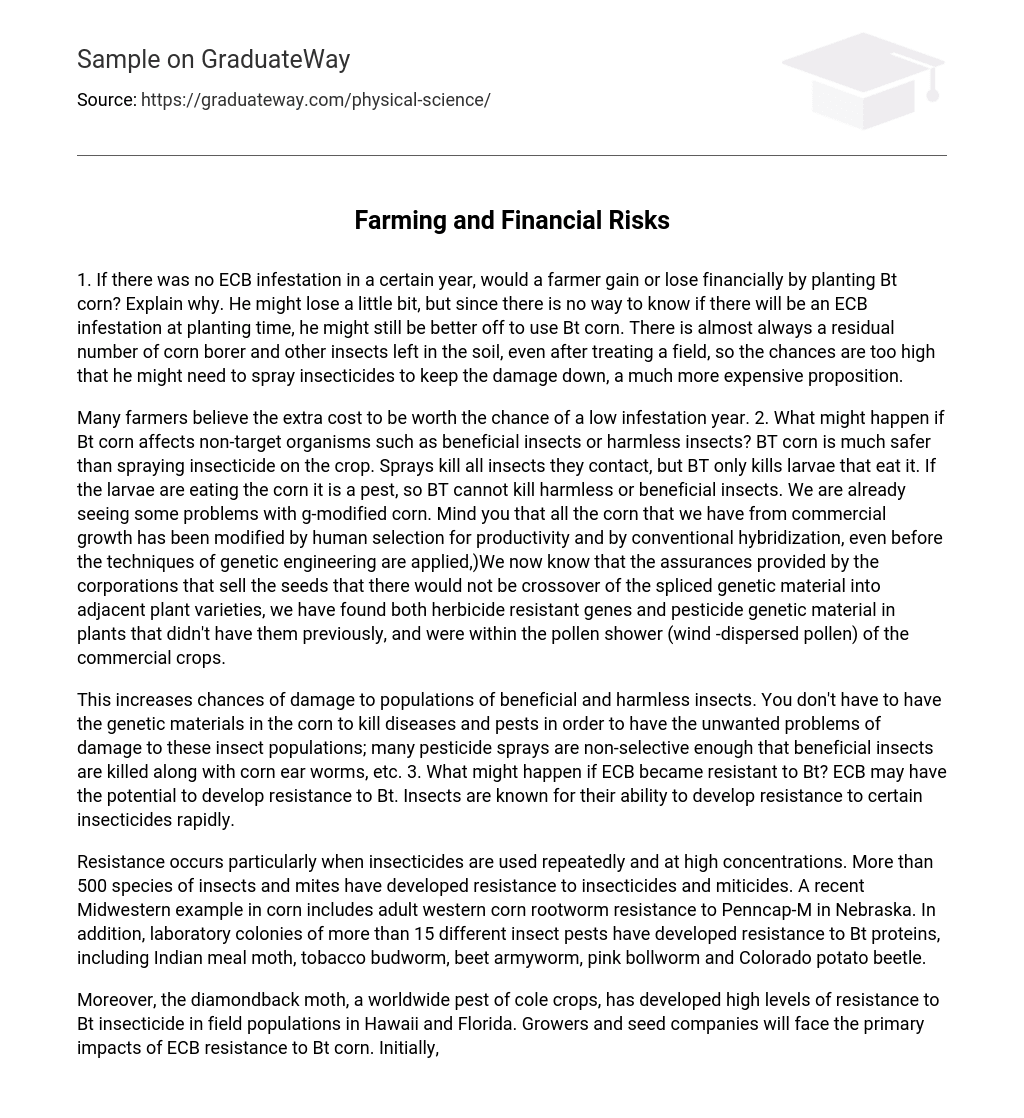Despite the possibility of a minor loss when planting Bt corn in a year without ECB infestation, it is still advantageous for farmers to utilize Bt corn due to uncertainty surrounding potential infestations during planting. Even after field treatment, there typically remains a population of corn borer and other insects in the soil. Consequently, the probability of requiring insecticides to mitigate damage is high, which incurs higher costs.
Many farmers believe that the added expense is justified by the potential for a reduced infestation year. 2. If Bt corn affects non-target organisms like beneficial or harmless insects, what could happen? Bt corn is considered safer than using insecticide on the crop because sprays kill all insects they come into contact with, whereas Bt only kills larvae that eat it. If the larvae are feeding on the corn, they are considered pests, so Bt does not harm harmless or beneficial insects. There are already some issues emerging with genetically modified (g-modified) corn. It is important to note that all commercial corn has been modified through human selection for productivity and conventional hybridization, even before genetic engineering techniques were applied. It has been discovered that despite assurances from seed-selling corporations that there would be no crossover of spliced genetic material into neighboring plant varieties, plants without herbicide-resistant genes or pesticide genetic material have been found to possess them after being exposed to pollen from commercial crops dispersed by wind.
The increased risk of harming populations of beneficial and harmless insects arises from the use of corn with genetic materials to combat diseases and pests. However, this can result in unintended damage to these insect populations as many pesticide sprays are not selective enough, causing harm to beneficial insects as well. If ECB (European corn borer) were to develop resistance to Bt (Bacillus thuringiensis), it could pose a potential threat as insects are known for their rapid development of resistance to certain insecticides.
Resistance to insecticides and miticides is a prevalent issue, especially when they are applied repeatedly and in high concentrations. Over 500 species of insects and mites have demonstrated resistance to these chemicals. For instance, Nebraska has reported adult western corn rootworm resistance to Penncap-M in corn crops. Laboratory colonies of over 15 insect pests, such as the Indian meal moth, tobacco budworm, beet armyworm, pink bollworm, and Colorado potato beetle, have also developed resistance to Bt proteins.
In addition, the diamondback moth, which is a global pest for cole crops, has evolved strong resistance to Bt insecticide in the field populations located in Hawaii and Florida. The main consequence of ECB resistance to Bt corn will be faced by growers and seed companies. Initially, in problem areas, producers might lose the ability to use Bt corn while seed companies and entomologists work on strategies to combat ECB resistance. In these areas, organic growers who depend on Bt insecticides may also lose a valuable method of managing pests.
Resistance effects may not be significant if hybrids that produce alternative proteins are successful and if they are quickly introduced into affected regions. However, ECB may develop resistance to multiple proteins. If resistance development renders entire groups of proteins ineffective, farmers could permanently lose the use of Bt corn and Bt insecticides as effective means of managing pests. This would be a disadvantage for organic farmers and other producers who depend on Bt insecticides.
In addition, if a voluntary, proactive resistance management plan is unsuccessful, it could result in heightened regulatory scrutiny for future transgenic crop technologies. This may potentially limit the application of a transgenic Bt approach for other valuable crops like sweet corn.
Considering the potential advantages and disadvantages of a transgenic organism such as Bt corn:
BENEFITS: Following the cultivation of Bt corn crops, farmers no longer have to worry about infestations caused by the European corn borer as these plants possess self-protective capabilities against these pests.
This decreases the necessity for chemical insecticides, leading to savings in expenses, workforce, and ecological damage. Bt toxin decomposes rapidly in the environment. Moreover, compared to traditional corn farming, employing Bt toxin results in increased crop production, satisfying the rising worldwide needs. The mechanism of action of Bt toxin is precise and extremely effective against corn borers without causing harm to non-target insects when consumed, making it safe for humans and animals.
CONCERNS:
– Low levels of Bt protein in transgenic plants may lead to the evolution of resistance in certain insects, similar to genetic resistance to chemical insecticides, making Bt technology less effective.
– Non-pest species, like Monarch butterfly larvae, can be harmed by consuming pollen from Bt corn plants, although recent studies show that natural Monarch larvae do not consume enough pollen to cause significant damage.
– Bt protein, not naturally occurring in the food chain, could potentially cause allergies, although allergenic potential was not found in analysis of the protein. GM crops should be routinely screened for allergenicity.
– Transgenes in Bt corn plants could potentially be transferred to closely related weeds via gene flow, allowing these weeds to become protected from insect infestations and compete with other crops for natural resources.
– A farmer planting Bt 123 corn in a field wants to estimate yield per acre. They count 22 ears in 1/1000 of an acre and determine that each ear has an average of 700 kernels.On average, he is aware that a bushel usually contains approximately 90,000 kernels.
What is the farmer’s estimated yield in bushels per acre? Let me break this down into smaller pieces: (22 ears) (1000 per acre) (700 kernels per ear) (1 bushel per 90,000 kernels) = 170 bushels per acre.
Additionally, describe the effects of the ECB infestations used. Were all corn varieties equally effective in controlling the ECB? When tested with a high infestation, each corn variety showed slightly smaller growth amounts in each yield. On the other hand, under low infestation, each corn variety showed larger growth amounts in each yield.





